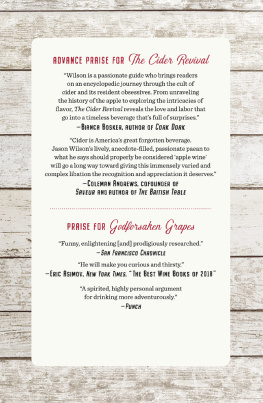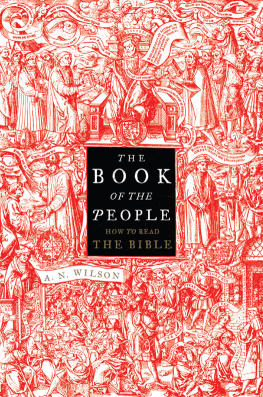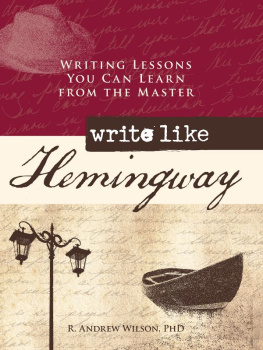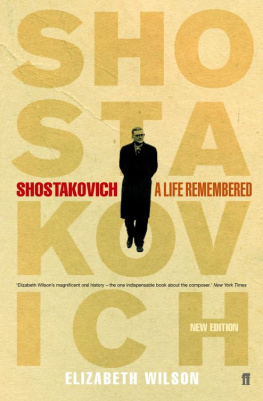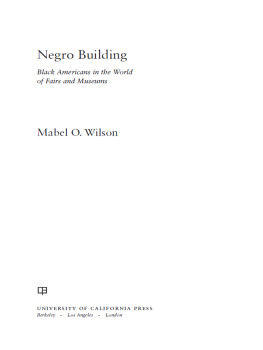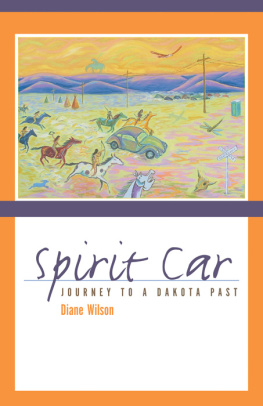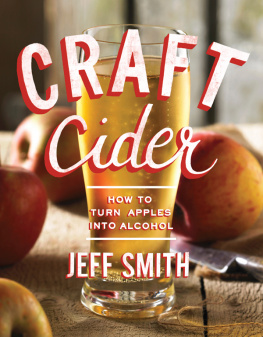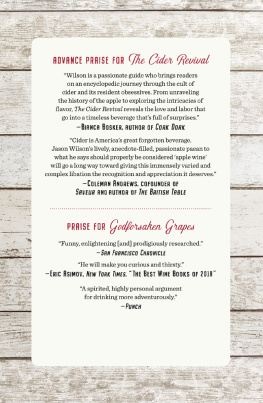Contents
Landmarks
Page List


ALSO BY THE AUTHOR
Boozehound: On the Trail of the Rare, the Obscure, and the Overrated in Spirits
Godforsaken Grapes: A Slightly Tipsy Journey through the World of Strange, Obscure, and Underappreciated Wine

Copyright 2019 Jason Wilson
Cover 2019 Abrams
Endpaper illustrations by Sam Brewster
Portions of this book have been adapted from previously published material in the Washington Post, the New York Times, and Preservation.
Published in 2019 by Abrams Press, an imprint of ABRAMS. All rights reserved. No portion of this book may be reproduced, stored in a retrieval system, or transmitted in any form or by any means, mechanical, electronic, photocopying, recording, or otherwise, without written permission from the publisher.
Library of Congress Control Number: 2018958805
ISBN: 978-1-4197-3317-8
eISBN: 978-1-68335-686-8
Abrams books are available at special discounts when purchased in quantity for premiums and promotions as well as fundraising or educational use. Special editions can also be created to specification. For details, contact specialsales@abramsbooks.com or the address below.
Abrams Press is a registered trademark of Harry N. Abrams, Inc.

ABRAMS The Art of Books
195 Broadway, New York, NY 10007
abramsbooks.com
To the apple of my eye
The revolution is not an apple that falls when it is ripe. You have to make it fall.
Che Guevara
CONTENTS
CHAPTER 1
CONFESSIONS OF A POMMELIER
CHAPTER 2
TERROIR & THE NORTHERN SPY
CHAPTER 3
WALDEN TO WURTSBORO
CHAPTER 4
THE CIDER MILL & THE CIRCUS
CHAPTER 5
PIPPIN AINT EASY
CHAPTER 6
NEW HAMPSHIRE IS A STATE. VERMONT IS A BRAND.
CHAPTER 7
THE LOST ORCHARDS
CHAPTER 8
TXOTX, YALL!
CHAPTER 9
THE WINTER MEETINGS
CHAPTER 10
THE JUDGMENT OF GRAND RAPIDS
CHAPTER 11
CIDERS LEAP TOWARD IMMORTALITY
CHAPTER 12
SELLING THE REVIVAL
CHAPTER 1
CONFESSIONS OF A POMMELIER
As I write this, I am drinking a cider made by a cult producer in New Yorks Catskills region called Aaron Burr Cidery, named after the treasonous vice president who (as you may have heard) shot and killed Alexander Hamilton in a duel. This particular bottling is labeled Sea Apples, and the apples used to make this cider were hand-foraged from wild, uncultivated trees along the shoreline of remote Isle au Haut off the coast of Maine by the cider makers, Andy Brennan and Polly Giragosian. The trees grow so close to the sea that a light film of salt forms on the apples skins as they ripen. This bottling was made from fruit harvested during the autumns of 2015 and 2016, and so when Im drinking it, the cider has a few years of age. Its funky, elemental, mineral, briny. The ripe, earthy apple aromas suggest a gnarled peel, but there are even more far-flung notes that taste closer to old amontillado sherry. Aaron Burr Cidery made only 21 cases of this cider, and it is difficult to find. Ive seen it retail at just under $30 for a 500-milliliter bottle, which is smaller than a standard wine bottle. Ive seen it on a drinks menu at a fancy restaurant in Manhattan for more than $50.
Suffice to say Aaron Burr Ciderys Sea Apples is about as far from that one, solitary mass-market cider your local craft beer bar probably keeps on tap. If youre like a lot of people, you drank that one cider once and found it sugary, cloying, boring, and something to avoid. You may have never drunk cider again. This is sad, because thats like drinking a glass of Yellow Tail or a cheap boxed wine or maybe even a Bartles & Jaymes wine cooler, and then deciding that all winewhite or red, sparkling or ros, Old World or New World, grand cru or gluggablesucks.
These days, in my wine fridge, I have dozens of excellent ciders. They crowd out much of the space that, until recently, was reserved for my favorite wines. I have bubbly ciders and still ciders, tannic ciders and acidic ciders, bone-dry ciders and off-dry ciders, ciders made of American heirloom apples, English bittersharp and bittersweet apples, Spanish apples, French apples, and wild crab apples. Most of these ciders come in 750-milliliter bottles, the standard-sized bottle for wine. Some are made in the same traditional method as Champagne. Others use apples that are macerated with their skins before pressing to achieve an effect similar to red wine. There are bottlings made from a single apple variety, such as 100 percent Northern Spy or Kingston Black or Geneva Tremlett, labeled just like pinot noir or chardonnay or cabernet sauvignon. I even have single-orchard and single-tree bottlings.
Most of the ciders are blends of colorfully named apple varieties: Newtown Pippin, Roxbury Russet, Brown Snout, Golden Russet, Harry Masters Jersey, Ashmeads Kernel, Esopus Spitzenburg, Ellis Bitter, Bulmers Norman, Wickson Crab, Zabergau Reinettejust to name but a few of the hundreds of unfamiliar apples with which one can make cider. Beyond those hundreds are thousands more unnamed varieties growing wild throughout North America, to be discovered by foragers like those at Aaron Burr Cidery. There are about 1,400 known wine grapes in the worlda fraction of the 7,500 apple varieties known to be cultivated. In the US alone there are more than 2,500 identified apple varieties in existence. There have been more than 16,000 varieties cultivated at one time or another in North America, though most of them are now extinct.
All of this may come as a surprise to drinkers who have experienced cider only through the prism of craft beer, consuming it from that one, sad, lonely tap handle at the bar. But you dont brew cider. Cider is essentially apple wine, made with fruit grown in an orchard in the same way wine comes from grapes grown in a vineyard. And like wine, cider can be made only once a year, after the fall harvest. Cider makers even use a version of the truism (or well-worn clich) that winemakers always repeat: Cider making begins in the orchard. This wine-like approach to cider has recently taken hold so fully that what has evolved is a new species of drinks person termed a pommelier, an expert on cider, akin to the sommelier.
Now, if the idea of a pommelier strikes you as utterly absurd, I do not blame you. I once shared your opinion. Only a couple of years ago, the idea of a pommelier existed in the same mental space where I filed other sommelier-wannabes. In my mind, pommelier ranked somewhere below the beer sommelier (or cicerone), the bourbon sommelier (or steward), or maybe even the cigar sommelier (or master tobacconist). Certainly, the pommelier was less ridiculous than the water sommelier, the olive oil sommelier, the tea sommelier, and the mustard sommelierall of which have also emerged over the past several years. But only slightly.
Its not that I didnt enjoy cider. I secretly loved the good stuff, particularly the complex, dry kind. My skepticism came from my work covering the world of alcoholic beverages. Cider, within this arena, has always been viewed as a second-class tipple. Ive written columns on cocktails, spirits, wine, and beer for newspapers and magazines for more than a decade, and only on a few rare occasions have I been permitted by an editor to slip a good word about cider into the mix. I was often trying to advocate for the ciders that I loved, from northern Spain or Normandy or a fine New England producer such as New Hampshires Farnum Hill. But something was always getting lost in the translation. One of my columns suggested cider as an alternative to wine at Thanksgiving. I still stand solidly by that advice, though Im pretty sure most readers had not sipped cider with their turkey since moving on from the sweet sparkling Martinellis juice they drank at the kiddie table. For another, even less successful article, I pitched cider as a summer, low-cal alternative to those awful Skinny Margaritas everyone was drinking in the late aughts. You get the picture: Cider always had to be positioned as an alternative to everything else.

